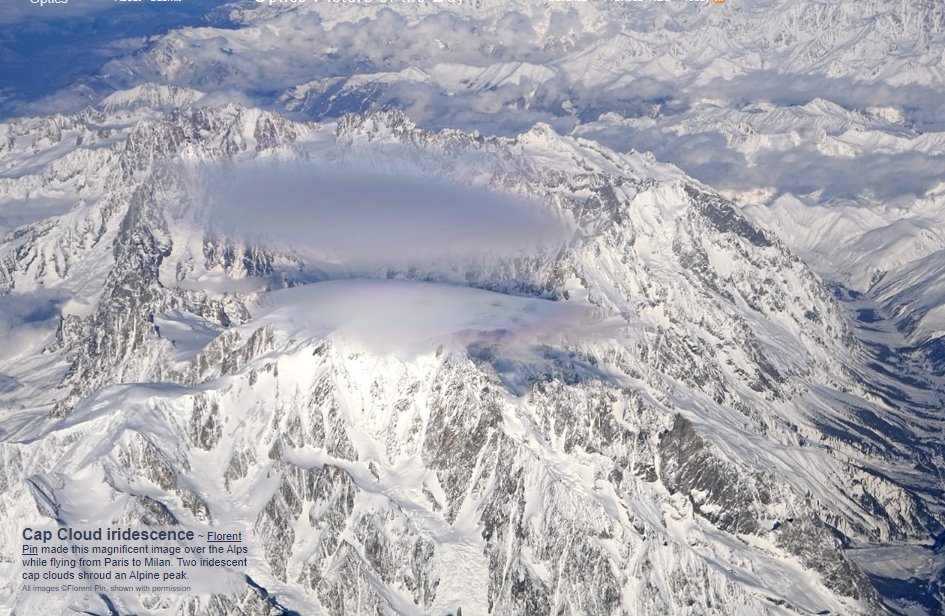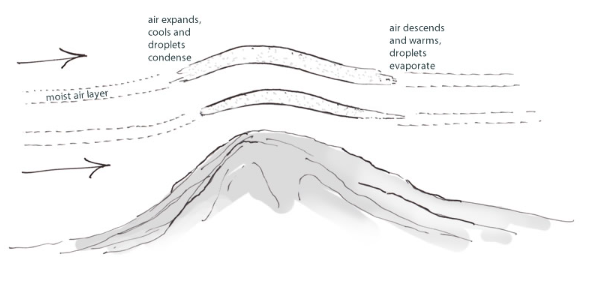Iridescent cap cloud over Alps - OPOD
Iridescent Cap Cloud over Alps: A Spectacular Phenomenon
When it comes to atmospheric optics, there are few sights as breathtaking as an iridescent cap cloud gracefully enveloping an Alpine peak. These captivating displays of nature's beauty were captured by photographer Florent Pin during a flight from Paris to Milan. The images showcase the ethereal quality of cap clouds, which are a type of orographic cloud that hovers almost stationary above mountain peaks. While they may appear serene, these clouds are filled with constant transience and change.
Cap clouds form as a result of wind passing over a mountain, forcing layers of moist air to rise. As the air ascends, its pressure decreases, causing it to expand and cool adiabatically. If the air contains enough water vapor, sudden condensation occurs, resulting in the formation of myriad small droplets that make up the cap cloud. Despite their appearance of stillness, cap clouds are actually buffeted by strong winds that howl through them. Droplets condense on the upwind side of the cloud and re-evaporate as the air layer descends, compresses, and warms on the other side.
One of the fascinating aspects of cap clouds is their propensity for iridescence. This phenomenon occurs due to the sudden condensation process, which leads to droplets of similar size and history within the cloud. These tiny droplets diffract sunlight, creating a mesmerizing display of pastel hues that dance across the sky. It is this unique combination of atmospheric conditions and droplet characteristics that gives rise to the enchanting iridescence observed in cap clouds.
To further appreciate and understand these captivating displays, it is helpful to have some knowledge of cloud identification. Ian Loxley of the Cloud Appreciation Society provides valuable insights into identifying different cloud formations. Cap clouds are just one example of the diverse range of clouds that grace our skies, each with its own distinctive characteristics and atmospheric conditions.
The images captured by Florent Pin not only showcase the beauty of iridescent cap clouds but also serve as a reminder of the dynamic nature of our atmosphere. These fleeting displays remind us of the constant interplay between wind, moisture, and temperature that shape our skies. It is through the lens of photographers like Florent Pin that we are able to witness and appreciate the remarkable phenomena occurring above us.
As we marvel at the iridescent cap clouds over the Alps, let us also take a moment to reflect on the intricate processes that give rise to such extraordinary sights. Nature continues to surprise and inspire us with its ability to create moments of unparalleled beauty, even in the most unexpected places.

Cap Cloud iridescence ~ Florent Pin made this magnificent image over the Alps while flying from Paris to Milan. Two iridescent cap clouds shroud an Alpine peak.
All images ©Florent Pin, shown with permission

Cap clouds are a variety of orographic cloud. They hover almost stationary over mountain peaks but inside them is all transience and change.
Cap clouds form when wind passing over the mountain forces layers of moist air upwards. Air made to rise has its pressure reduced. The air expands and in doing so it adiabatically cools. If its water vapour content is high enough, there is sudden condensation into myriad small droplets – a cap cloud.
The apparently quiescent cloud actually had wind howling through it. Droplets condense on the upwind side. They re-evaporate on the other side as the air layer starts to descend, compress and warm.
The sudden condensation favours iridescence because the droplets all have similar histories and therefore sizes. The tiny droplets diffract sunlight to form the characteristic pastel hues.
Thanks to Ian Loxley of the Cloud Appreciation Society for help with cloud identification.
Note: this article has been automatically converted from the old site and may not appear as intended. You can find the original article here.
Reference Atmospheric Optics
If you use any of the definitions, information, or data presented on Atmospheric Optics, please copy the link or reference below to properly credit us as the reference source. Thank you!
-
<a href="https://atoptics.co.uk/blog/iridescent-cap-cloud-over-alps-opod/">Iridescent cap cloud over Alps - OPOD</a>
-
"Iridescent cap cloud over Alps - OPOD". Atmospheric Optics. Accessed on April 19, 2024. https://atoptics.co.uk/blog/iridescent-cap-cloud-over-alps-opod/.
-
"Iridescent cap cloud over Alps - OPOD". Atmospheric Optics, https://atoptics.co.uk/blog/iridescent-cap-cloud-over-alps-opod/. Accessed 19 April, 2024
-
Iridescent cap cloud over Alps - OPOD. Atmospheric Optics. Retrieved from https://atoptics.co.uk/blog/iridescent-cap-cloud-over-alps-opod/.